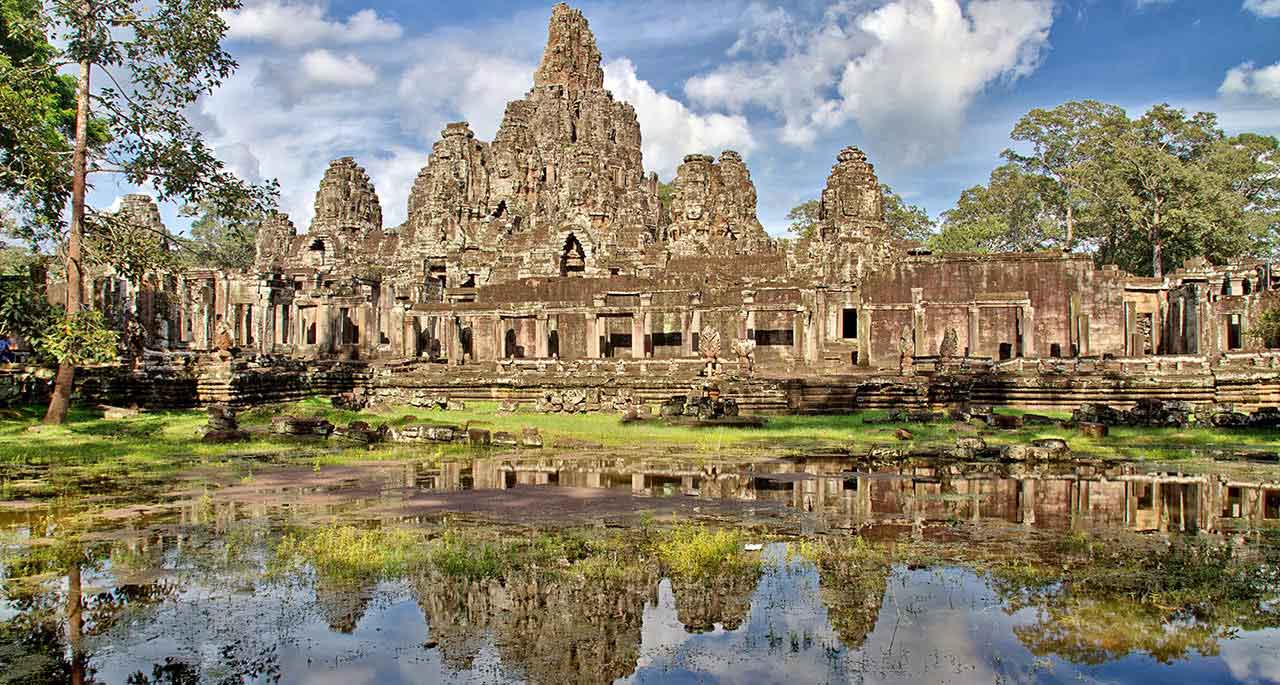My travel expedition to Siem Reap started off with the plane touching down at Phnom Penh International Airport ( formerly Pochentong International Airport) and since this was my first trip to that South East Asian country, I was more than excited to explore the unknown and the mysterious. Such is the expectation Cambodia has conjured in me but Phnom Penh was set to change my presumptuous mindset as my guide cum driver headed into the crowded city of 2.2 million people which astonishingly, looked a little over populated than urban Kuala Lumpur. The city’s urban landscape is braced with modern buildings and busy traffic. Judging by its vibrant environment, bustling Phnom Penh depicted itself as a new and progressive Asian metropolitan, whose burgeoning tourism industry is transforming itself into one of the most most popular places to visit in the region. As our vehicle weaved slowly through the crowded morning avenues, one can sense that the transport users in the city are well mannered and respectful of each other. There was hardly any encounter of an accident even if it might seem to be a minor one. The next few days in Phnom Penh made me to discover and apprise the Cambodian capital more profoundly but somehow or rather the real tourist draw for the Kingdom of Cambodia is still at the ancient city of Siem Reap, located some 6 hours drive to the north. By my own choice of indigence, I opted for the coach to travel over to Siem Reap which literally means “ The Defeat of Siam” . The surface journey allows you to to see the country more intimately and meet the real people on the ground. Since my arrival to the Land Of the Khmers, I have discovered that the locals were indeed very tourist friendly and infectiously generous with their warm smiles. The uninterrupted journey across the country encompassing the flat terrain of the northern provinces brings to your eyes the charms and absolute stunning beauty of the local villages interspersed with the ubiquitous rice paddy country side vistas. Provided that you keep yourself awake most of the time, the snacks and refreshments served onboard would hardly make you survive the journey without sleeping.
Siem Reap is probably the most visited region out of Cambodia because of the Angkor Archaeological Park’s existence. Even if you are “templed out” from neighboring countries like Thailand and Myanmar, you are highly recommended to visit the historical temples in Siem Reap for they are grand beyond a traveler’s figment of realization. If you are visiting it for a few days it is definitely wise to hire a tuk-tuk (taxi) to see as much of Angkor and the outlying temples as you can fit in. Visitor passes that are valid from 1 to 3 days are available at the main entrance to entice even the most avid photographer, painter, writer or historian. True to its preservation efforts initiated by UNESCO, visitors also have the option to rent a bicycle if they prefer, but some of the distances under the scorching sun in high season requires a lot of physical stamina for the climbing endurance, and I mean really a lot! The temples of Angkor Wat , Angkor Thom and Bayon are generally the most heavily visited by tourists on a day’s run. And when you are already done with some of the world’s most famous temples, head to the old market at Psar Chaa, where you can haggle over diverse locally produced souvenirs from the other provinces some colourful and some intricate but almost merely affordable. The markets not only trade in mementos and interesting genuine – like relics and artifacts but also in local preserved fruits and snacks, including fried insects like locusts and roaches which are strictly meant for the adventurous aphrodisiac lovers.
When night falls, Siem Reap injects an excitement of non-stop action packed social indulgences like no other secondary city in rural South East Asia can offer , be it bawdily or culturally. The pulse of activities are heavily concentrated at the Pub Street enclave, where backpackers and group tourists converged to savour international meals or live band entertainment, amidst the myriad of souvenir shops and retail massage service outlets that complement each other’s presence. Notable for every tourist to experience would be the enchanting performance of the Apsara Dance specially choreographed by the Royal court artisans for so many generations and recognized by UNESCO as an extinct dance art form. With their snappy dance forms and colorful costumes, the Apsara represents what most Cambodian people truly hold in common i.e – grace, poise and persona.
BEST TIME TO VISIT
The best time to visit Cambodia is between April and November where there is a relatively lengthy wet season, otherwise generally Siem Reap adapts to a tropical wet and dry climate. The city is generally hot throughout the course of the year, the average high temperatures in the city never falls below 30 C in any month. The dry season covers from the month of December till March each year.
Article from SUTRA Newsletter, Issue 26:
https://www.sutra.my/wp-content/uploads/2015/04/Issue-26-Q4-2014.pdf





















